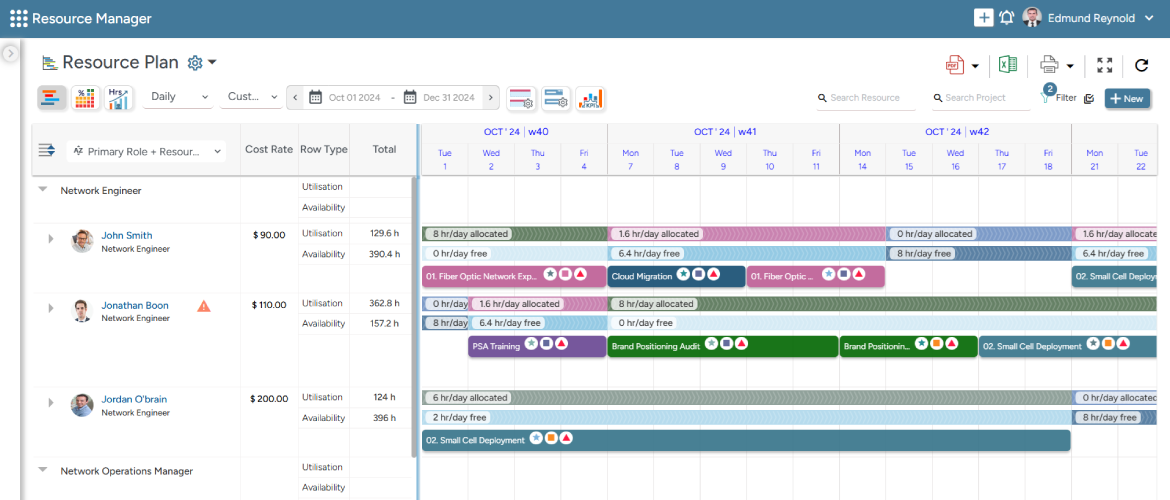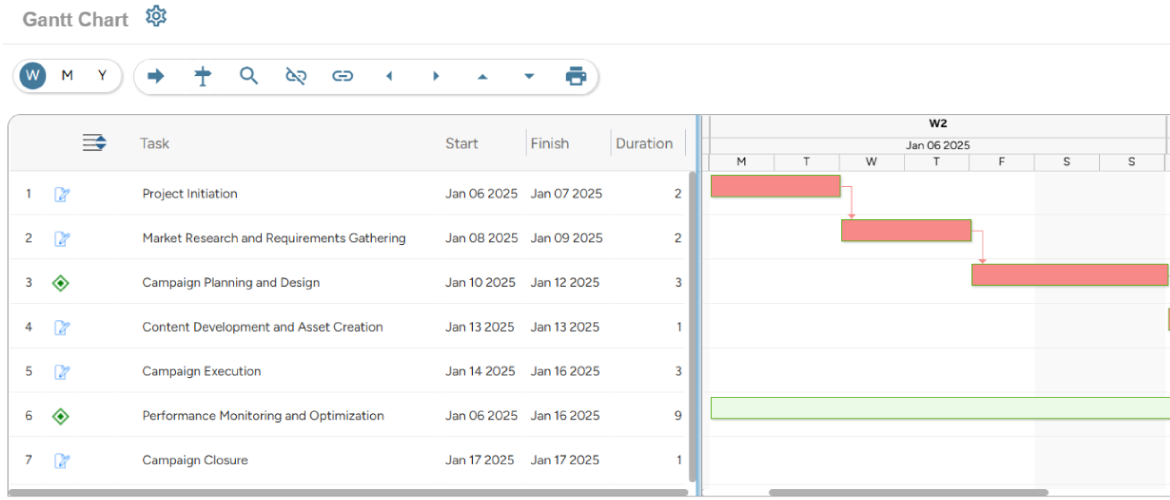Project management is a composite discipline of processes, principles, skills, knowledge, and experience required to meet its deliverables amid various constraints. A project manager must know how to orchestrate the numerous moving parts, adapt to changes, and motivate the team to deliver desired results.
Therefore, a manager needs a framework that sets the structure, direction, and pace of the project. That’s where project management principles come in. These core rules provide consistency, alignment, and control across every phase of a project lifecycle. When followed, the principles ensure that teams move with purpose, stakeholders stay informed, and project goals are met on time and within budget.
This blog explores the top 12 principles of project management that every manager should understand, master, and apply to drive successful outcomes.
Let’s begin!
What are the Principles of Project Management?
Project management principles are foundational guidelines that provide a structured and efficient approach to managing projects from initiation to closure. These principles outline key aspects of successful project execution, such as scope management, resource allocation, risk management, stakeholder engagement, and performance monitoring.
These principles are applicable across industries and various project types, making them crucial assets for high-quality outcomes. In addition, the principles of project management are not rigid rules but a flexible framework. They help managers stay focused, adapt to changing circumstances, address unforeseen challenges, and remain aligned with project goals.
Now that we know what project management principles are, let’s understand their significance.
Why are Project Management Principles Important?
According to PMI, “Organizations collectively lose $2 trillion annually due to poor project management practices.”
This staggering figure highlights the importance of establishing robust project management principles and practices across all levels of an organization. Here are some key reasons why project management principles are essential:
- Helps managers make informed decisions, allocate resources effectively, and navigate challenges like scope creep, budget overruns, etc., by ensuring clear project goals, objectives, and structure.
- Enhances transparency, improves team collaboration, and reduces misunderstandings through a well-structured project communication plan.
- Ensures alignment with organizational goals and enhances stakeholder satisfaction through regular engagement and feedback.
- Promotes process consistency, enhancing efficiency, better quality control, and improved ability to adapt to changing project demands by following standardized approaches.
- Enhances ownership and accountability, ensuring every team member understands their responsibility and project objectives with the help of clearly defined roles and reporting structures.
- Fosters continuous improvement, helping teams to refine their strategies and enhance future project performance.
Top 12 Project Management Principles Every Manager Should Master
Let us now explore the top 12 project management principles that every manager should master:
Clearly Define Project Goals & Objectives
Every project is approved to serve a purpose, be it to meet business needs, drive innovation, or solve a problem. One of the critical project management principles is to define project goals from the outset. These objectives act as a roadmap, aligning the team’s efforts toward a shared vision. Without well-defined objectives, any project will lose focus, leading to scope creep, delays, and inefficiencies.
While setting project objectives, project managers should also ensure they are specific, measurable, attainable, relevant, and time-bound. For example, an e-commerce company plans to redesign its website and increase the conversion rate by 20% within six months. This is a SMART goal as it is specific, measurable, and time-bound.
Create the Project Structure
A solid project structure is the backbone of successful project delivery. It provides a clear framework that simplifies planning, streamlines execution and improves the ability to track progress at every stage. The process begins with creating a detailed schedule and budget plan to ensure resource alignment and define how project funds will be utilized.
Another crucial part of creating a project structure is building a Work Breakdown Structure (WBS), which is a hierarchical framework that divides the project into smaller, manageable tasks. This approach enhances visibility, simplifies task delegation, and ensures smooth project execution.
Read More: How to Build a Work Breakdown Structure? A Step-by-Step Guide
Define the Roles & Responsibilities
A successful project relies on every team member knowing exactly what they’re responsible for. When roles and responsibilities are clearly defined from the start, individuals understand their tasks, reducing confusion, preventing task duplication, and improving collaboration. Clearly assigning responsibilities also promotes ownership, allowing team members to take the initiative within their scope of work.
Managers can use frameworks like the RACI Chart (Responsible, Accountable, Consulted, Informed) to make this process more structured. This matrix ensures the team knows their role, who to report to, and who needs to be consulted for key decisions. Setting clear expectations and documenting them eliminates ambiguity, reduces bottlenecks, and enhances employee productivity.
Develop a Resource Fulfillment Plan
Creating a resource fulfillment plan is one of the critical project management principles that helps resource managers identify, forecast, and allocate resources to the projects at the right time and cost. For example, let’s assume that there is a software development project. Once the project manager evaluates the project’s scope and estimates the resource demand, they submit a request to the resource manager.
Now, the resource manager assesses the new requirements, finds the gap between the demand and the available workforce, and looks for ways to fill this gap. They may acquire new market resources (permanent or contingent workers) or train the existing workforce. Thus, resource fulfillment planning helps forecast resource requirements, address shortages/excesses, and prevent costly hirings.
Read More: What is a Contingent Worker? Examples, Benefits & Best Practices
Implement Robust Risk Management Strategies
Risk is an inherent part of every project. Managing it begins with identifying risks at every stage with the help of historical data analysis, stakeholder discussions, etc. Once risks are identified, they must be categorized based on source or impact area (e.g., financial, operational, technical) and prioritized by likelihood or severity. This thorough assessment enables teams to build an informed response strategy.
A comprehensive risk management plan includes creating a risk register to log and monitor potential risks. It further involves evaluating the impact and likelihood of each risk and developing a response strategy to avoid, reduce, transfer, or accept them. By embedding risk management into the project’ score planning process, the team can stay prepared and ensure timely delivery, even in uncertain conditions.
Build a Solid Communication Plan
PMI states, “About 90% of the time in a project is spent on communication by the project manager.”
This emphasizes the importance of continuous communication in a project – whether through emails, chat service, meetings, or formal reports. A well-structured communication plan ensures that team members know what information needs to be shared, who needs to receive it, how frequently it should be communicated, and through which channels. This clarity helps prevent information silos and misunderstandings.
For example, in a large-scale software development project, developers may use real-time chat services for quick updates, project management tools to track tasks and timelines, and weekly meetings for discussing significant roadblocks. Meanwhile, stakeholders might receive monthly reports summarizing key progress and project milestones.
Read More: Project Milestones: How to Manage Them Effectively for Project Success?
Ensure Stakeholder Communication & Engagement
Stakeholders are key contributors to the project’s direction and approval. That’s why ensuring consistent stakeholder communication and engagement is imperative for effective project management. When project stakeholders are not aligned, it can lead to unclear expectations and delayed decisions.
On the other hand, keeping stakeholders informed and involved throughout the project lifecycle fosters alignment, promotes transparency, and facilitates timely decision-making. Project managers can enhance stakeholder trust and build confidence by implementing structured touchpoints such as monthly review meetings, detailed project reports, and periodic feedback sessions.
Create a Change Management Framework
Several variables are involved in a project, like budget, resources, scope, and timelines, and these can change during the project due to internal or external factors. That’s why implementing a change management framework is one of the pivotal project management principles, as it ensures that changes are handled in a structured manner without disrupting the project’s stability.
A structured process allows teams to evaluate proposed changes in terms of feasibility and assess their impact on cost and budget. For example, suppose a client requests additional features in a software project. In that case, the Change Control Board (CCB) evaluates the request, assesses its implication, and determines whether to approve, defer, or reject it. This approach enables teams to remain flexible.
Read More: What is Change Management in Project Management, and Why Is It Important?
Establish Robust Quality Standards and Control
Delivering successful projects isn’t just about meeting deadlines and staying within budget. It is also about ensuring that the project’s final output meets or exceeds stakeholders’ expectations. That’s why setting quality standards and control is one of the most important project management principles. Quality management involves setting clear benchmarks for project deliverables.
To ensure consistent quality, project managers must define and continuously monitor key performance indicators (KPIs) such as defect rate, rework levels, compliance metrics, and customer feedback. Proactive quality control allows teams to detect and resolve issues early, ensuring the project meets established quality standards without delays or inefficiencies.
Set Project Performance Baseline
Establishing a performance baseline is essential for tracking progress and controlling key project parameters. This baseline typically includes key metrics such as project budget, scope, timeline, and resource allocation. It serves as a reference point, helping project managers to detect deviations and take corrective measures to ensure the project stays on track.
For instance, if actual costs begin to exceed the budget baseline, project managers can take corrective actions like reallocating resources or renegotiating vendor contracts, postponing non-essential tasks, or identifying cost-saving alternatives to prevent overruns and maintain efficiency. Thus, a clearly defined and closely monitored project baseline strengthens decision-making and supports successful project delivery.
Read More: How to Develop an Effective Project Budget in 8 Simple Steps?
Emphasize Value Delivery
Project management isn’t just about completing tasks – it’s about delivering real value. That’s why one of the core project management principles is ensuring that every action and decision aligns with overarching business goals and stakeholder expectations. Managers must regularly assess whether their efforts drive meaningful outcomes and contribute to long-term success.
To achieve this, managers should encourage a value-driven mindset. Instead of focusing solely on outputs, they should emphasize enhancing customer experience, improving efficiency, or driving business growth. In addition, regular feedback and iterative improvements help keep the project aligned with its purpose.
Conduct Post-project Evaluation
A post-project evaluation is essential to assess the success of the project. It includes reviewing lessons learned reports to understand what contributed to success and what could be improved. A structured evaluation consists of gathering feedback from stakeholders and teams, analyzing project performance, and documenting key takeaways.
Moreover, by reflecting on what worked well and where gaps occurred, project managers can refine strategies, optimize workflows, and improve execution in future initiatives. This reflective approach promotes continuous improvement and helps organizations build a repository of knowledge that can be leveraged in future projects.
Now that we have learned about different principles of project management let us explore how a modern resource management tool can help implement these principles.
Read More: Top 14 Project Management Methodologies: Tips to Choose the Right One
How Can a Project Resource Management Tool Help Implement These Principles?
Effective project management requires the right tools to streamline planning, execution, and decision-making. The following features of an advanced project resource management tool empower managers to apply these principles effectively:
- The software’s all-in-one resource planner allows managers to slice and dice the resource information across multiple dimensions like role, experience, expertise, location, cost, etc. This comprehensive visibility allows them to facilitate competent resource allocation.

SAVIOM’s All-in-One Resource Planner is a single source of truth for all resource-related data, helping managers slice & dice necessary information.
- The tool offers managers detailed insights into resource utilization, availability, etc., with real-time BI reports. Moreover, the color-coded heatmaps provide quick insights into under/overallocation, enabling managers to take corrective actions.
- With integrated Gantt Chart, project managers can define task dependencies, set key milestones, and allocate resources to individual activities. Furthermore, it provides a clear timeline that helps managers effectively monitor project progress.

SAVIOM’s Gantt Chart offers a bird’s-eye view of project timelines, dependencies, and resource allocations — helping managers plan, track, and adjust schedules with precision.
- The in-built collaboration platform ensures all stakeholders stay informed with real-time updates and project milestones. It eliminates information silos, enhances team coordination, and supports transparent communication.
- The what-if scenario modeling enables managers to compare scenarios and choose the most efficient resource plan. Thus, it prevents resourcing bottlenecks and helps in maintaining an optimized workforce.
Conclusion
While no two projects are ever the same, the right combination of strategy, tools, and adaptability empowers managers to navigate uncertainty with confidence. Project management principles lay the groundwork, but their true value lies in how effectively they’re applied in real-world scenarios. Ultimately, the key to project success isn’t just smart planning, it’s about executing with clarity, agility, and purpose.
So, what are your go-to project management principles for success?
The Glossary
Read More: Glossary of Resource Workforce Planning, Scheduling and Management











